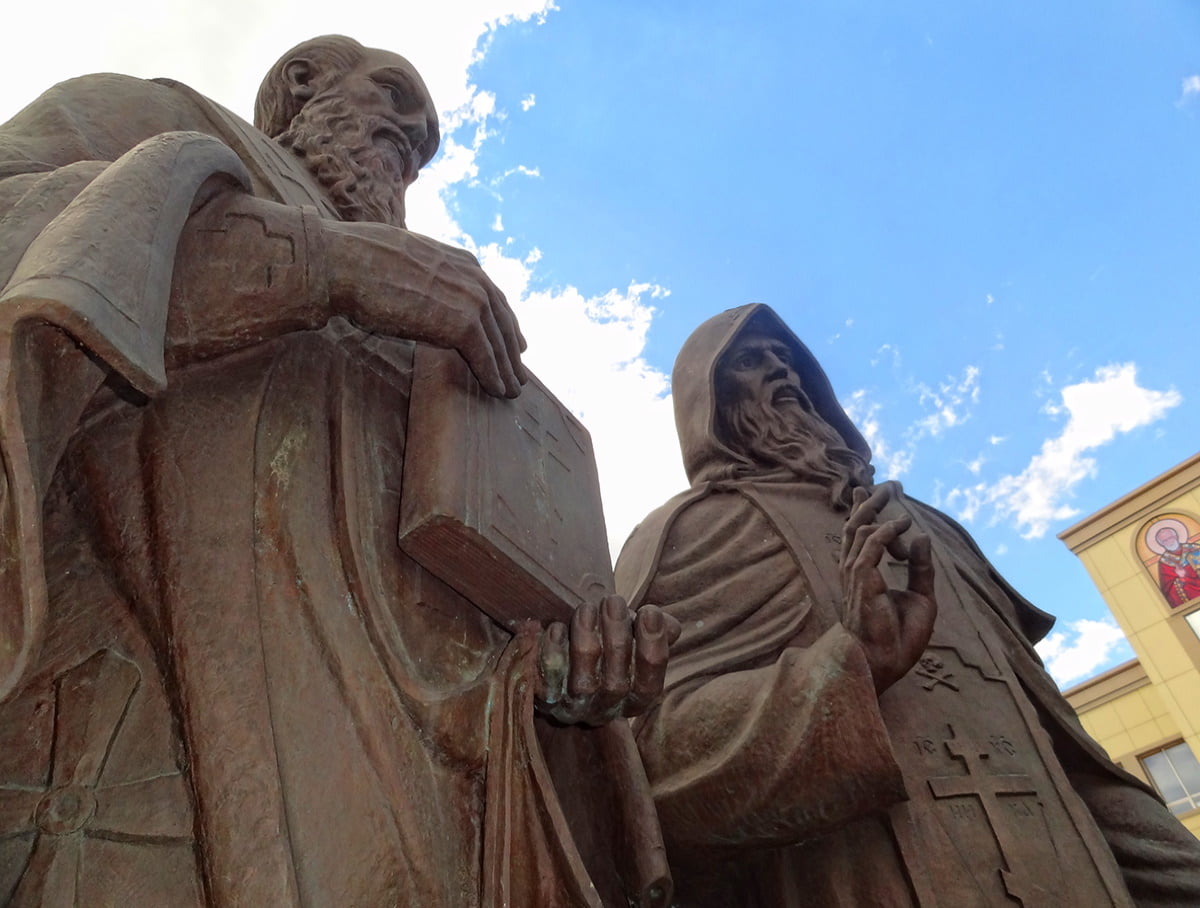Many believe that the creators of the modern Russian alphabet many centuries ago were two monk brothers, who were later canonized. We checked how convincing this version is.
This is what the fund's information portal reports "Russian World": “The Greek alphabet continued the history of its development and became the basis for another alphabet - the Cyrillic alphabet. The ancient Slavs also needed their own alphabet. They decided to turn to the Greeks themselves for help. To do this, in 863 the Slavs invited the learned Greek brothers Cyril and Methodius, who knew the Slavic language very well. Cyril and Methodius took letters from the Greek alphabet, invented some letters themselves and created the Cyrillic alphabet. The alphabets of many languages are based on Cyrillic: Russian, Bulgarian, Serbian, Ukrainian, etc.”
You can hear about this in the program "News", in TV channel programs "World 24" and a number of Russian regional TV channels, read on sites universities and on the portal "Lesson.rf"
First of all, let's understand who Cyril and Methodius are. According to ideas modern historians, the brothers were born in the city of Thessaloniki (as the Slavs called Greek Thessaloniki) in the first half of the 9th century with a difference of 12 years, and the eldest, although he is mentioned second in the pair, was Methodius. More precisely, he became Methodius much later (most likely, having taken monastic vows), but his worldly name remains unknown. Cyril’s name in pre-monastic life was Constantine. In his youth, Methodius, like his father, was engaged in administrative activities for the benefit of the Byzantine Empire, while Constantine immediately chose the path of religious enlightenment. In any case, by 862, when the Byzantine emperor Michael III An embassy arrived from the Great Moravian prince Rostislav with a request to send a missionary to Moravia (the territory of modern Czech Republic), the brothers were well known at court, and it was they who were entrusted with this mission. The choice was due to the fact that Thessaloniki at that time was a bilingual city, and the brothers were fluent in the local Slavic dialect, while the Moravians were also Slavs.
It was this invitation that played a key role in the emergence of the Slavic alphabet. To translate and present the fundamentals of Christian doctrine, the brothers needed to develop a system of signs that would reflect the phonetic features of the language of their future students. And although the Slavic dialects at this stage of their development were very similar, neither Cyril nor Methodius knew all the intricacies of the language spoken by the Moravians. Therefore, the basis Old Slavonic language, which will soon become the main one as a liturgical and canonical dialect among the Western, Southern, and later Eastern Slavs, lay down the dialect widespread in the vicinity of the native Soluni brothers. Over time, the Old Church Slavonic language transformed into Church Slavonic, used today along with national languages. However, like Latin, today it is a dead language that does not exist outside the specific environment of human activity.
Now about the most important thing. As you know, there are two ancient Slavic alphabets: Cyrillic and Glagolitic. Strictly speaking, the first term combines several concepts at once - this is a whole family of modern alphabets used in almost two dozen independent states (not counting the languages of autonomous entities), and the so-called statutory font (which was replaced by civil), and, finally, the basis of all of the above is the Old Church Slavonic alphabet called “Cyrillic”:

The Glagolitic alphabet, almost completely coinciding with the Cyrillic alphabet in the structure of the alphabet and the sound meaning of the letters, is very different from it in the style of the symbols:

The very peculiar appearance of the elements of the Glagolitic alphabet does not allow us to unambiguously associate it with any letter known today, although countsthat many letters go back to Greek, and some to Semitic. In Ancient Rus', the Glagolitic alphabet was used very little - in the form of separate inclusions in Cyrillic texts, inscriptions, and also for secret writing. At the same time, until the middle of the 19th century, the theory of the precedence of the Cyrillic alphabet over the Glagolitic alphabet dominated in science. Doubts arose in 1836, when the Glagolitic manuscript, now known as "Klotz's Collection". It dates back to the 11th century, but this was far from the limit, as subsequent discoveries showed. A whole mass of ancient texts in the Glagolitic alphabet was soon discovered in Constantinople by a Russian linguist Victor Grigorovich, who, in parallel with the Slovak scientist Pavel Safarik, put forward convincing evidence in favor of the fact that the Glagolitic alphabet is older than the Cyrillic alphabet. The work of scientists at the turn of the 19th and 20th centuries confirmed this theory. The oldest surviving Glagolitic inscription with precise dating dates back to 893 and was made in the church of the Bulgarian Tsar Simeon in Preslav:

There are other arguments in favor of the seniority of the Glagolitic alphabet, and exactly:
1. Monuments written in Glagolitic alphabet are connected precisely with those regions (Moravia and Pannonia) where the activities of the Slavic first teachers took place, as well as with Croatia and Macedonia, where the direct students of Cyril and Methodius, expelled from Moravia, worked. The oldest Cyrillic monuments known to us are found, as a rule, in the east of the Balkan Peninsula, where the brothers had no direct influence;
2. Monuments written in Glagolitic alphabet are, as a rule, more archaic in language than Cyrillic texts;
3. The Glagolitic alphabet is less perfect in the composition of its letters than the Cyrillic alphabet;
4. The Cyrillic alphabet uses a number of letters denoting sound combinations that could have appeared among the Slavs only from the end of the 9th - beginning of the 10th century. These are the letters “xi” and “psi” borrowed from the Greek alphabet. There were no such letters in the Glagolitic alphabet, since in the middle of the 9th century the Slavs could not have the corresponding sound combinations;
5. In monuments written in Cyrillic, there are often individual words or interspersed letters in Glagolitic notation. The opposite occurs only in cases where the Cyrillic postscript was obviously made later;
6. Parchment (the main writing material in those days) was quite expensive, so scribes often resorted to using an old book to write a new text. The text written over the old (washed off or scraped off) inscription was called a palimpsest. Among the known palimpsests there are Cyrillic manuscripts written in the washed-out Glagolitic alphabet, but there is not a single Glagolitic monument written in the washed-out Cyrillic alphabet.
And finally, about the personalities of the creators. It can be assumed that Cyril and Methodius first created the Glagolitic alphabet, and then they also came up with the Cyrillic alphabet. However, modern scientists for the most part do not agree with this statement. According to tradition, the Cyrillic alphabet was created by a student of Cyril and Methodius Kliment Ohridski, in 893 chosen one "Bishop of the Slavic language." In his short life you can read: “[Clement] also came up with other styles for letters, so that they would be clearer than those invented by the wise Cyril.” It’s hard to argue with the last statement - indeed, the Cyrillic alphabet is much easier to use. However, scientists are not sure that it was Clement who continued the work of the two brothers. Speaks out assumption, that it could also be his contemporaries Naum Ohridski and Konstantin Preslavski. One way or another, the overwhelming majority of scientists believe that Cyril and Methodius invented the Glagolitic alphabet, and only it.
Most likely not true
If you find a spelling or grammatical error, please let us know by highlighting the error text and clicking Ctrl+Enter.







